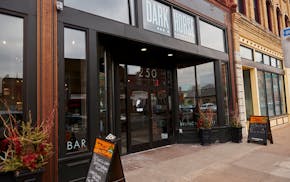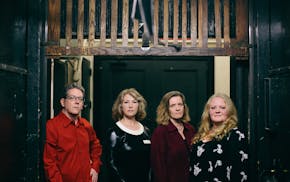Rain was just letting up as folks started arriving at Roberts Bird Sanctuary in southwest Minneapolis. Groups meet there most weekend mornings in the spring to see and hear migrating warblers, waterfowl, woodpeckers, owls and more than 100 other species that reside in or pass through the Lake Harriet-adjacent habitat.
The day's outing was put on by the Audubon Chapter of Minneapolis in partnership with Birdability, a national nonprofit devoted to making birding accessible for people of all abilities.
Mark Paller of Minneapolis, a retired physician and former executive vice dean of the University of Minnesota Medical School, has led half a dozen such outings over the past couple of years. An avid outdoorsman, he discovered birding later in life when muscular dystrophy eroded his pursuits of canoeing and backpacking. With a fully charged battery on his electric wheelchair, he can go 15 miles on a bird-watching trail.
If the trail can handle it, that is.
Big rocks and exposed tree roots, fresh gravel, sand, steps and steep inclines can make a trail impassible for anyone using a wheelchair, scooter or walker. Online descriptions and signage gloss over these details, forcing people who may want to use the trail to either risk the unknown or, more often, stay home.
According to the Centers for Disease Control, over a quarter of adults in America live with a disability, which include mobility and cognitive disabilities as well as hearing and vision impairments. Add to that people with a short-term injury, children with disabilities or in strollers and the 62 million Americans who are 65 or older, and it's clear why making the outdoors easier to access is a growing focus for many organizations.
"Over the course of our lives, we may all be on this spectrum of access needs, disability, aging and life stage. The introduction of access really benefits everyone," said Cat Fribley, Birdability's executive director, on a recent Zoom meeting for current and potential future "captains."
The organization has more than 40 captains in 28 states, including Paller, who volunteer to host events, advocate for better trail access, contribute to the crowd-sourced Birdability Map and stay current on accessibility related topics.
The Birdability Map features hundreds of parks, trails and other birding locations around the world that meet the organization's criteria of being "reasonably" accessible. Key features —including parking, bathrooms, benches, shade cover, trail length and an overall accessibility score — are covered in the listings.
Rather than saying something is (or isn't) accessible, Birdability stresses the importance of providing enough details so users can decide whether the location or event will work for them. "What's accessible to me is not the same as what's accessible to someone else," Fribley said.
Paller and Fribley are quick to point out that access doesn't mean, as Paller put it, "paving over everything." If planned and maintained properly, wooden boardwalks, dirt paths and grass all can be accessible to people with mobility challenges.
Providing more details
Many local organizations, including the Minneapolis and St. Paul Audubon chapters, Minnesota Ornithologists Union, and park systems including Three Rivers Park District, are following Birdability's lead. Cathy Crogan, field trip coordinator for the St. Paul Audubon Society, said the chapter started expanding its trip difficulty labels from one word to something more descriptive last year.
"Our goal is to better describe the trip, and let the reader draw their own conclusion about difficulty," she said. The chapter also is adding "bird sits" to its calendar for participants who want to go birding with others from a single location.
For Michael Hurben of Bloomington, having a companion or guide is essential in unfamiliar places. Hurben has retinitis pigmentosa, which limits his field of vision to what's directly in front of him — not ideal for spotting a skittish bird in dense vegetation, he said.
But that hasn't stopped him and his wife from traveling to 45 countries and all seven continents in search of birds. Last year in Turkey, he added species number 5,000 to his all-time bird list.
Many of Hurben's adventures are chronicled on his website, Legally Blind Birding, including how he shifted his own mindset to accept that hearing a bird counts just as much as seeing one.
"My advice is no matter what your disability or limitation, there is always going to be something that you can do," he said, from putting up a feeder in your backyard to learning bird songs. "Learning how to [identify birds] by ear is a wonderful challenge, and will keep you busy for a long time," he added.
(Hurben is taking a break from adding birds to his list to write a book; "The Physics of Birds and Birding" is slated for release next spring.)
Where to go birding
Some of the metro area's most accessible birding spots are equally beloved by birders of all abilities. The Minnesota Valley National Wildlife Refuge in Bloomington, Veterans Memorial Park in Richfield and Silverwood Park in St. Anthony are among the region's top-rated locations on the Birdability Map.
At Eastman Nature Center, part of Maple Grove's Elm Creek Park Reserve, nesting pairs of scarlet tanagers, indigo buntings and broad-winged hawks can be observed adjacent to the building and parking lot. The center will hold its next "Every Body Can Bird" event there on Sept. 14.
Paller and others praised Three Rivers Park District, which manages Elm Creek, for its accessibility. A range of adapted equipment, including all-terrain wheelchairs, Nordic walking and trekking poles and other mobility devices are available upon request. Many park programs cater to visitors with a wide range of disabilities.
Those looking to explore more rugged terrain can check out the Minnesota Department of Natural Resources' track chairs at 13 state parks. The chairs can traverse trails that standard wheelchairs cannot. Visitors are asked to call ahead to reserve one free of charge.
The Friends of Roberts Bird Sanctuary worked with the Minneapolis Park and Recreation Board to build an accessible terrace connected to the shelter where the recent Birdability event took place. Opened last fall, the terrace is level with the sidewalk and parking lot and provides a place for everyone to enjoy the sanctuary.
"Sitting and waiting and watching is peaceful. It's also really good for those of us who have mobility issues," Paller said. Benches will be added later this summer.
As the outing at Roberts wrapped up, the group gathered by the parking lot to say their goodbyes. While they lamented the morning's low bird count, a ruby-throated hummingbird and black-capped chickadee stopped by to smell the true indigo planted next to the handicap parking spots.
Erica Wacker is a St. Paul-based freelance writer.

The 5 best things our food writers ate this week

A Minnesota field guide to snow shovels: Which one's best?

Summer Camp Guide: Find your best ones here

Lowertown St. Paul losing another restaurant as Dark Horse announces closing

